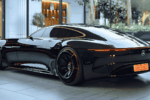Kawasaki has always been at the forefront of motorcycle innovation, pushing the boundaries of design and performance. With the unveiling of the Kawasaki J Concept, the brand has taken a bold leap into the future of mobility. This futuristic three-wheeled hybrid motorcycle isn’t just a design experiment. it’s a glimpse of what next-generation motorcycles could look like. Combining cutting-edge technology, adaptive design, and eco-friendly performance, the J Concept showcases Kawasaki’s vision for the evolution of personal transportation.
What is the design philosophy behind the Kawasaki J Concept
The Kawasaki J Concept is unlike anything seen before. Its design represents the perfect blend of form and function, merging a sci-fi aesthetic with real-world practicality. The three-wheeled configuration gives it superior stability, while its sharp, aggressive styling draws inspiration from futuristic machines. The body features flowing lines, aerodynamic curves, and a dynamic front end that can adjust its stance based on the rider’s needs.
The most striking aspect of the J Concept is its transforming design. In its “Sport Mode,” the motorcycle lowers itself and extends the front wheels outward, creating a low, aggressive position perfect for high-speed riding. In contrast, the “Comfort Mode” raises the bike’s stance, bringing the wheels closer together for a more upright and relaxed riding posture. This dual nature allows the J Concept to adapt to different terrains, riding styles, and comfort preferences.
The glowing green accents, digital display panels, and sleek LED lighting reinforce its futuristic appeal. Kawasaki’s goal was to design a motorcycle that doesn’t just look advanced but feels alive, capable of responding intuitively to the rider.
When Kawasaki plans to make the J Concept a reality
The Kawasaki J Concept was first introduced as a prototype at major auto shows, and while it has yet to enter production, the company continues to refine its electric and hybrid technologies. The concept represents Kawasaki’s long-term plan to introduce hybrid and electric motorcycles into its lineup by the end of this decade.
Industry insiders suggest that while a production-ready version of the J Concept may not arrive before 2026 or 2027, many of its innovations such as adaptive riding geometry and hybrid propulsion systems will likely influence future Kawasaki models. The company’s commitment to sustainability and intelligent mobility means that the J Concept is more than just a design study; it’s a roadmap for the motorcycles of tomorrow.
How the hybrid powertrain redefines performance
At the heart of the Kawasaki J Concept is a revolutionary hybrid powertrain that combines an electric motor with a traditional combustion engine. This dual setup provides the flexibility of electric riding in urban areas and the performance of a gasoline engine for long-distance travel. Riders can switch between fully electric, hybrid, and performance modes depending on their needs.
In electric mode, the J Concept operates silently, producing zero emissions ideal for city commuting or eco-friendly travel. When switched to hybrid mode, both the electric motor and gasoline engine work together, delivering a powerful surge of torque and acceleration. This system allows for both performance and efficiency, aligning with Kawasaki’s “Go Green” initiative while preserving its signature high-performance DNA.
The bike’s advanced energy management system monitors battery charge, engine load, and riding conditions to ensure optimal efficiency. Regenerative braking technology also helps recharge the battery while slowing down, maximizing range without sacrificing performance.
What is the unique three-wheeled design advantage
The J Concept’s three-wheeled layout isn’t just for show. it offers a major leap in control, stability, and rider confidence. The dual front wheels provide a wider contact patch, improving grip during cornering and braking. This means riders can lean aggressively into turns while maintaining superior balance compared to traditional two-wheelers.
The adjustable suspension system adapts automatically to road conditions, ensuring a smooth ride on both urban streets and rough terrains. Additionally, the transforming chassis enhances aerodynamics at higher speeds and stability during slower, more relaxed rides.
Kawasaki’s engineers designed the steering system to maintain a natural motorcycle feel, giving riders the agility and responsiveness they expect while offering extra security on challenging surfaces. It’s a balance of innovation and tradition. a machine that feels both futuristic and familiar.
How the Kawasaki J Concept enhances rider interaction
The Kawasaki J Concept isn’t just about mechanical performance. it’s also about intelligent human-machine interaction. The motorcycle features an AI-driven interface that communicates directly with the rider. A futuristic digital dashboard projects essential data like speed, battery level, power mode, and navigation in a customizable layout.
The system can also learn from the rider’s habits, adjusting power delivery, suspension settings, and ride height accordingly. Voice command support and gesture recognition allow for hands-free control, minimizing distractions and enhancing safety.
Moreover, the seating and handlebar positions automatically adjust to match the selected ride mode, creating a tailored riding experience. This level of personalization makes the J Concept one of the most rider-focused machines ever envisioned by Kawasaki.
When the future of motorcycle design takes inspiration from the J Concept
The J Concept represents a turning point for the motorcycle industry. Kawasaki’s vision goes beyond producing another high-performance bike. it’s about reimagining what personal mobility can be. The combination of electric and combustion technology, adaptive geometry, and intelligent systems reflects the brand’s dedication to pushing the boundaries of engineering.
Future production motorcycles may borrow elements of the J Concept’s design, including hybrid drivetrains, self-adjusting ergonomics, and smart connectivity. The idea is to make motorcycles more sustainable, safer, and more adaptable to modern lifestyles while retaining the thrill and freedom that define riding.
How the Kawasaki J Concept symbolizes the future of riding
The 2025 Kawasaki J Concept isn’t just a motorcycle it’s a vision of transformation. It merges futuristic design with advanced hybrid engineering and intelligent adaptability. It shows how the motorcycles of tomorrow could evolve to meet environmental demands, rider safety, and performance expectations all at once.
By combining the agility of a sportbike, the stability of a three-wheeler, and the sophistication of hybrid power, Kawasaki has created something that feels ahead of its time. The J Concept stands as proof that the future of motorcycling is not only about speed it’s about smart, sustainable innovation that connects machine and rider like never before.
As Kawasaki continues to refine its hybrid and electric technologies, the J Concept remains a bold symbol of what’s coming next a future where power meets intelligence, and performance meets responsibility.



